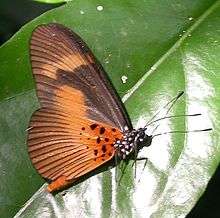Bematistes epaea
Bematistes epaea, the common bematistes, is a butterfly in the family Nymphalidae. It is found in Senegal, Guinea-Bissau, Sierra Leone, Liberia, Ivory Coast, Ghana, Togo, Benin, Nigeria, Cameroon, Equatorial Guinea, the Republic of the Congo, Angola, the Democratic Republic of the Congo, Sudan, Ethiopia, Uganda, Kenya, Tanzania, Malawi and Zambia.[2] The habitat consists of forests and dense Guinea savanna.

| Common bematistes | |
|---|---|
| Scientific classification | |
| Kingdom: | Animalia |
| Phylum: | Arthropoda |
| Class: | Insecta |
| Order: | Lepidoptera |
| Family: | Nymphalidae |
| Genus: | Bematistes |
| Species: | B. epaea |
| Binomial name | |
| Bematistes epaea | |
| Synonyms | |
| |
Both sexes are mimicked by Elymniopsis bammakoo, Pseudacraea eurytus and Mimacraea darwinia, while the female is also the model for the female of Papilio cynorta. Acraea jodutta is probably a co-mimic.
The larvae feed on Lindaeckeria schweinfurthii, Lindaeckeria dentata and Adenia cisampelloides.
Subspecies
- B. e. epaea (Senegal, Guinea-Bissau, Liberia, Ivory Coast, Ghana, Togo, Nigeria, Cameroon, Congo, Angola, western Democratic Republic of the Congo, north-western Tanzania, Zambia)
- B. e. angustifasciata d'Abrera, 1980 (central and southern Uganda, western Kenya)
- B. e. bicolorata (Le Doux, 1937) (south-eastern Democratic Republic of the Congo)
- B. e. epitellus Staudinger, 1896 (coast of Kenya, coast of Tanzania)
- B. e. homochroa (Rothschild & Jordan, 1905) (southern Ethiopia)
- B. e. insulana Ackery, 1995 (Bioko)
- B. e. kivuana (Jordan, 1910) (Democratic Republic of the Congo: east to Kivu)
- B. e. lutosa (Suffert, 1904) (eastern Democratic Republic of the Congo, Uganda: west to the Bwamba Valley)
- B. e. melina (Thurau, 1903) (south-western Tanzania, Malawi: north to the shores of Lake Malawi)
- B. e. paragea (Grose-Smith, 1900) (Sudan, western Uganda, western Kenya, north-western Tanzania)
gollark: Modern general purpose compression algorithms are also somewhat better than they were and improving.
gollark: 100Gbps and up networking is also apparently a thing which exists for data centres and whatnot now, even if most of us peasants are still stuck on 1Gbps.
gollark: FHD and up ones being everywhere is seemingly more recent.
gollark: Also compact power supplies for phones and such.
gollark: Cheap low power high resolution display panels I guess.
References
| Wikimedia Commons has media related to Bematistes epaea. |
| Wikispecies has information related to Bematistes epaea |
- "Acraea Fabricius, 1807" at Markku Savela's Lepidoptera and Some Other Life Forms
- "Afrotropical Butterflies: Nymphalidae - Tribe Acraeini". Archived from the original on 2012-08-10. Retrieved 2012-06-01.
External links
- Die Gross-Schmetterlinge der Erde 13: Die Afrikanischen Tagfalter. Plate XIII 58 a
- Die Gross-Schmetterlinge der Erde 13: Die Afrikanischen Tagfalter. Plate XIII 59 c paragea
- Die Gross-Schmetterlinge der Erde 13: Die Afrikanischen Tagfalter. Plate XIII 59 e homochroa
- Images representing Bematistes epaea at Bold
- Images representing Bematistes epaea melina at Bold
- Images representing Bematistes epaea paragea at Bold
- Images representing Acraea paragea at Bold
- Images representing Acraea paragea kivuana at Bold
- Acraea epaea epaea at Pteron
This article is issued from Wikipedia. The text is licensed under Creative Commons - Attribution - Sharealike. Additional terms may apply for the media files.